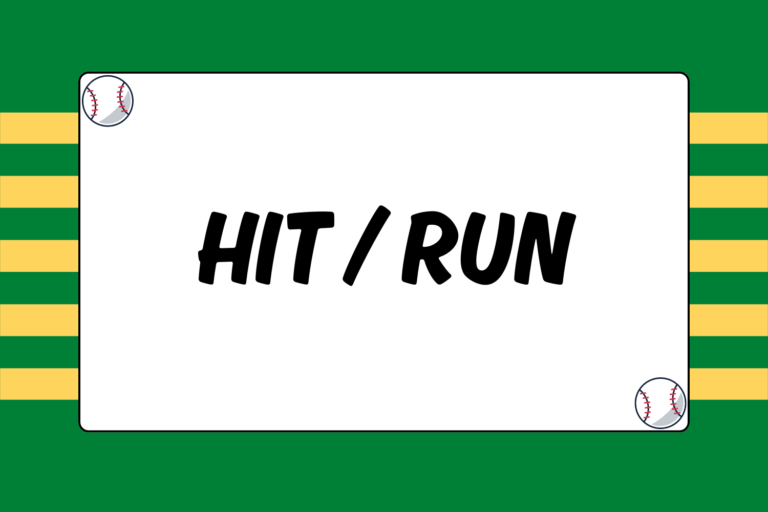Making out a lineup card is easy, right? Fastest guy leads off, best hitters at the top, worst hitters at the bottom. Well that’s a decent start, but there are actually a lot more factors to consider when building your team’s batting order. The last thing you want is to hinder your offense by having the wrong guys batting in the wrong situations or failing to utilize your most productive hitters. This guide breaks down each spot in the lineup and some important points to consider so your offense can get the most out of each at-bat and each inning.
No. 1
It’s widely accepted that the lead-off hitter is the fastest guy on the team, or at least the best base-stealer. It’s important to remember, however, that the lead-off hitter – the catalyst, so to speak – may only actually lead off an inning once per game. You can never guarantee that he will be the one to start your rallies and make things happen on the base paths. What you can guarantee is that no one will bat more times over the course of a game than the lead-off hitter.
What’s more, the lead-off hitter is likely to bat with runners on base more often that you might think. As such, the lead-off man should be one of your better hitters. Speed is important, good base running is even more important. However, the ability to get on base is perhaps the most important quality. Ultimately, you want your No. 1 hitter to be your most versatile and dynamic player. More specifically, hitting for contact (and not striking out), bunting, base stealing, and hitting with some occasional power are all abilities to covet in a good lead-off man.
No. 2
The second batter in the lineup may or may not be your best hitter, but he should usually be your most fundamentally sound offensive player. The No. 2 batter is the one you will most likely ask to perform the widest variety of tasks. Most of the time that task will be to get base hits. Because of that, he should have a good batting average and on-base percentage. But because of his spot near the top of the order, in front of the best run producers, he will do more than just set the table by getting on base.
The No. 2 man should be able to execute sacrifice bunts and hit-and-runs, as well as make productive outs to move runners. He should also be a smart base runner. This doesn’t necessarily mean he has the speed to steal a lot of bases, but it means he does a good job reading batted balls, taking extra bases, avoiding base-running mistakes, and picking good spots to swipe a bag. The second batter doesn’t need to have a lot of home run power, but it’s possible that he could be your most reliable offensive player.
No. 3
This will usually be the best hitter on the team. The reason for this is that the third spot is situated in the best place to accumulate both runs and RBI (what you might call “team stats”). He doesn’t have any major holes on his swing, he doesn’t get consistently beat by a particular pitch, and he never shrinks from a situation. Your third hitter sets the tone for the rest of your offense by battling and being the toughest out on the team.
It may be that the No. 3 hitter bats .350 or it may be that he bats .260. He may hit a lot of home runs or a lot of doubles or maybe not. The type of production you want from the three-hole isn’t necessarily as important as the fact that you get production. The third hitter is in that spot because he gets the job done with the most frequency; he’s on base, he’s driving in runs, he’s at the center of scoring rallies. No matter what type of hitter he is, he’s the guy you want up when you need a clutch hit or when the game is on the line.
No. 4
The clean-up man is probably your second or third-best hitter, but most importantly, he’s a prolific run producer. The four-hole is often where you put the guy with the most power, so even if he strikes out sometimes, he hits a lot of home runs and extra-base hits.
He protects the third hitter, so he needs to be someone who inflicts a certain level of fear into the opponent. Hitting fourth means he will frequently get a chance to bat with runners on base, so he’s the type of hitter than can consistently drive in runs.
In order to be successful, your team has to take advantage of scoring opportunities, which means the batters in the middle of the lineup have a high success rate of bringing runners home. The clean-up hitter may not have the best batting average on the team (although he might), but there’s a great chance he has the most RBIs. At the very least, the four-hitter rarely has bad at bats, takes his walks when the opponents give them, and, like the three-hitter, is a focal point of much of the team’s scoring.
No. 5
The fifth hitter is a little like the junior clean-up batter (or the back-up clean-up hitter, if you will). He should possess a lot of the same qualities as the No. 4 man. Batting fifth means that he, too, will get a great deal of chances to bat with runners on base, and ideally he is also a reliable run producer. He might not be as consistent a hitter (maybe having a worse batting average, more strikeouts, etc.) as the guys at the top of the order, but he still plays a major role in the offense.
The five-hole is potentially a very important lineup spot. Depending on how deep and talented your team is, at some point in the batting order there will be a drop-off in production and consistency. The fifth hitter is in the very middle of the lineup, and in some cases, may bat in situations in which he represents your best chance to drive in runs, since there are less reliable hitters to follow. If your five-hitter is good enough that he could hit third or fourth, it’s likely that your team will be very productive on offense.
Nos. 6 & 7
Your team’s success on offense will have a lot to do with the amount of production that you can get out of the six and seven spots. It could be that there is a major drop-off in talent after the first four or five hitters, or it could be that you’re so loaded that your No. 6 and 7 guys are reliable enough to hit in the middle of the lineup. When you reach these lineup spots, it gets easier to make decisions.
Each of the first five hitters have certain roles to fill and certain qualities that you want. In most cases, though, they will be the five best hitters on the team. Therefore, the next-best hitter bats sixth, and the next-best hitter after that bats seventh. It’s possible that these guys bring something valuable to the table (power, speed, batting average, a good eye, or perhaps the ability to hit from both sides of the plate), but they’re probably less consistent and/or less dangerous hitters than the guys at the top.
You might have a .300 hitter batting seventh because he’s just a singles hitter, or because he rarely takes a walk. Ideally, though, you want these guys to be productive at least some of the time, because they’re likely to get quite a few chances with runners on base, and occasionally you need offensive rallies from the bottom of the lineup.
No. 8
At the big league level, there have been No. 8 hitters to win batting titles or hit 20-plus home runs in a season. There have also been eight-hole hitters to bat under .200. So obviously, it depends on the depth of your team. However, it is entirely possible that the eighth batter is the worst hitter – or perhaps, the least-valuable hitter – in the lineup (for reasons that will be explained more in the next section).
Maybe the man in the eight hole is a slow, light-hitting catcher with some occasional power, or perhaps a solid second baseman who simply brings very little to the table offensively. Simply put, the eighth slot is probably the best place to hide a weak offensive player in your lineup without hindering your run production too much. On the flip side, you ideally want to have someone in that spot who can drive in runs and get on base with some regularity. Or even better, your No. 8 guy could be a poor man’s No. 2 hitter – that is, he’s a smart player who can do a lot of things well on offense, but may not be as reliable a hitter as the man hitting second.
No. 9
It may seem obvious to bat your worst hitter ninth. In some cases, that will be the way to go. But the reason why this might not be a good idea is that the ninth hitter often serves as a table setter the same way a lead-off hitter does. After the first inning, there technically isn’t a top and bottom to your lineup, so the man hitting ninth can effectively serve as a second lead-off hitter. He can potentially set things up for the guys at the front of the order. At the very least, you hope your No. 9 hitter is someone who doesn’t give away too many outs.
You might bat the player with the fewest tools eighth so that your nine-hole batter (while maybe not a great hitter) is someone who can bunt well, handle the bat, steal some bases, and make things happen with the “inside game.” The strength of your ninth batter may not be as important to the team’s success as the guys in the middle, but having a serviceable offensive player batting last can make your lineup that much more potent.
An Inexact Science
There are additional mitigating factors to consider when making a lineup, some of which are difficult to anticipate because they depend on the individuals on the team. Some coaches like to split up their left-handed and right-handed hitters (or stagger them in the order, so to speak). The idea behind this is to make it more difficult for the opponent to play match-ups. If you have three straight lefties in the order, then it could be an easy decision for the opposing coach to bring in a left-handed pitcher to face those guys.
As a result, you might have a guy hitting seventh who could be hitting fifth or sixth simply to split up the lefties and righties. In addition, there is no one “right” way to do this. Players’ individual talents and tendencies must play a huge role in how you construct a lineup. For example, you may have a really good hitter who gets on base and absolutely flies. But it’s possible that he doesn’t hit well when he leads off, so you have no choice but to bat him lower. Or it could be that your No. 6 hitter leads the team in home runs, but he has to hit sixth because he’s pitched to differently when he hits fourth and isn’t nearly as productive.
The above guidelines are fairly well accepted standards. Just the same, they are only guidelines. Ultimately, the goal of making a lineup is to get the most possible production out of each hitter in the order.





